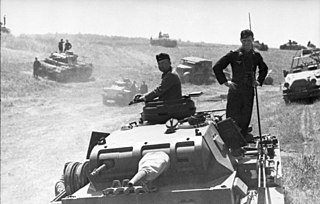
The Sturmpanzer is a German armoured infantry support gun based on the Panzer IV chassis used in the Second World War. It was used at the Battles of Kursk, Anzio, Normandy, and was deployed in the Warsaw Uprising. It was known by the nickname Brummbär by Allied intelligence, a name which was not used by the Germans. German soldiers nicknamed it the "Stupa", a contraction of the term Sturmpanzer. Just over 300 vehicles were built and they were assigned to four independent battalions.

The Panzerjäger I was the first German tank destroyer to see service in the Second World War. All mounted the Czech Škoda-built 4.7 cm KPÚV vz. 38 antitank gun on a converted Panzer I Ausf. B chassis. It was intended to counter heavy French tanks like the Char B1 bis that were beyond the capabilities of the 3.7 cm Pak 36 anti-tank gun and extended the life of the obsolete Panzer I chassis. A total of 202 Panzer I chassis were converted to Panzerjäger I standard in 1940–41, and were employed in the Battle of France, in the North Africa Campaign and on the Eastern Front.

Panzerjäger is a German-language term to denote certain anti-tank vehicles and formations. The term was first used in the Wehrmacht (1935–45), and was subsequently used in Bundeswehr (1955–) jargon as well. The term Panzerjäger was also used in the Bundeswehr as a designation of rank.

The 1st Panzer-Division was an armoured division in the German Army during World War II.

The 10th Panzer Division was an armoured division in the German Army, the Heer, during World War II, established in March 1939.

A Panzer division was one of the armoured (tank) divisions in the army of Nazi Germany during World War II. Panzer divisions were the key element of German success in the blitzkrieg operations of the early years of World War II. Later the Waffen-SS formed its own panzer divisions, and the Luftwaffe fielded an elite panzer division: the Hermann Göring Division.
The Fallschirm-Panzer-Division 1. Hermann Göring was a German Luftwaffe armoured division. The HG saw action in France, North Africa, Sicily, Italy and on the Eastern Front during World War II. The division began as a battalion-sized police unit in 1933. Over time it grew into a regiment, brigade, division, and finally was combined with the Parachute-Panzergrenadier Division 2 Hermann Göring on 1 May 1944 to form a Panzer corps under the name Reichsmarschall. It surrendered to the Soviet Army near Dresden on 8 May 1945.

The 13th Panzer Division was a unit of the German Army during World War II, established in 1940.

The Panzer-Lehr-Division was an elite German armoured division during World War II. It was formed in 1943 onwards from training and demonstration troops stationed in Germany, to provide additional armored strength for the anticipated Allied invasion of western Europe. On 4 April 1944, the division was officially designated as the 130th Panzer Division; however, it is usually referred to as the Lehr Division. It was the only Wehrmacht Panzer division to be fully equipped with tanks and with halftracks to transport its mechanized infantry. On several occasions it fought almost to destruction, in particular during Operation Cobra, and by the end of the war in Europe bore little resemblance to the unit that had originally been activated.

The 78th Infantry Division, later known as the 78th Assault Division, was a German infantry formation which fought during World War II. After the 78th Assault Division was destroyed near Minsk in July 1944, the 78th Volksgrenadier Division was created.
The 7th Panzer Division was an armored formation of the German Army in World War II. It participated in the Battle of France, the invasion of the Soviet Union, the occupation of Vichy France, and on the Eastern Front until the end of the war. The 7th Panzer Division is also known by its nickname, Ghost Division.
Kampfgruppe 1001 Nights was a German Kampfgruppe formed on the Oder front during the final German offensive of the Second World War, taking part in the failed attack on Genschmar on 27 March 1945.
This is the complete order of battle of Allied and German forces involved during Operation Market Garden.
XLVII Panzer Corps was a panzer corps of the German Army in World War II that was formerly designated as XLVII Corps. Various formations of the corps fought in the French campaign of 1940, in the invasion of Soviet Union from 1941 to 1944, and on the Western Front from June 1944 until April 1945.

The 15 cm sIG 33 (Sf) auf Panzerkampfwagen I Ausf B, sometimes referred to (unofficially) as the Sturmpanzer I Bison, was a German self-propelled gun used during World War II.

The 25th Infantry Division was a military unit of the German Wehrmacht. It was later reclassified to 25th Motorized Infantry Division, and in June 1943 to the 25th Panzergrenadier Division.

The Sonderkraftfahrzeug 8, usually abbreviated to Sd.Kfz. 8, was a German half-track designed by Daimler-Benz that saw widespread use in World War II. Its main roles were as a prime mover for heavy towed guns such as the 21 cm Mörser 18, the 17 cm Kanone 18 and the 10.5 cm FlaK 38, however it was also capable of serving as an infantry transport. Approximately 4,000 were produced between 1938 and 1945. It was used in every campaign fought by the Germans in World War II, notably the Invasion of Poland, the Battle of France, the Balkans Campaign, the Eastern Front, the North African Campaign, the Battle of Normandy and the Italian Campaign.
The 708th Infantry Division was a German Army infantry division in World War II.
The Panzer Division Jüterbog was an armoured division of the Wehrmacht during World War II. Created on 20 February 1945, it was active for a short period of time.
The 8.8 cm Flak 18 (Sfl.) auf Zugkraftwagen 12t , also known as the Bunkerflak or Bufla, was a German Wehrmacht half-track self-propelled gun developed before World War II and used in the first half of the war. It was used during the Invasion of Poland but is best known for its use during the Battle of France, where it was the only German self-propelled gun capable of destroying the heavier Allied tanks such as the French Char B1 and the British Matilda II. Remaining vehicles were used on the Eastern Front. The last Bufla was destroyed in 1943.











